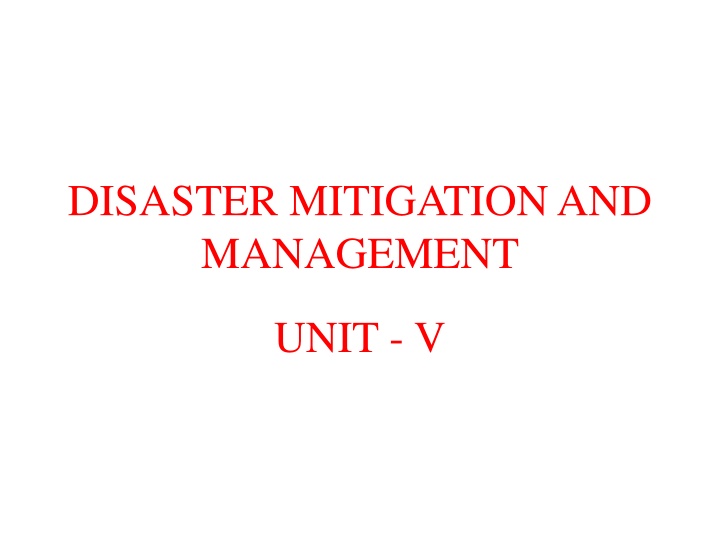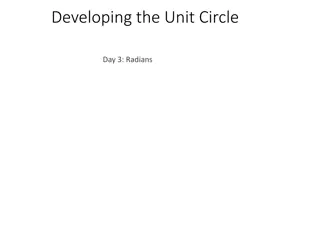
India's Vulnerability to Natural Disasters and Emergency Management
India faces significant risks from a variety of natural disasters including earthquakes, floods, cyclones, droughts, and more. With a high vulnerability due to its geo-climatic factors and socio-economic conditions, the country has experienced devastating losses over the past three decades. It is crucial for India to focus on disaster mitigation and efficient emergency management practices to reduce the impact of disasters and protect its population and economy.
Download Presentation

Please find below an Image/Link to download the presentation.
The content on the website is provided AS IS for your information and personal use only. It may not be sold, licensed, or shared on other websites without obtaining consent from the author. If you encounter any issues during the download, it is possible that the publisher has removed the file from their server.
You are allowed to download the files provided on this website for personal or commercial use, subject to the condition that they are used lawfully. All files are the property of their respective owners.
The content on the website is provided AS IS for your information and personal use only. It may not be sold, licensed, or shared on other websites without obtaining consent from the author.
E N D
Presentation Transcript
DISASTER MITIGATION AND MANAGEMENT UNIT - V
PROFILE OF INDIA History of disasters during last three decades 431 Disasters occurred in India during last thirty(30) years 1,43,039 people died US$ approximately 4800 crore loss has been incurred
VULNERABILITY PROFILE OF INDIA India is highly Vulnerable to disaster due to its unique Geo-Climatic and Socio-economic conditions Highly earthquakes,landslides,avalanches,forest fires vulnerable to floods,drought,cyclones, 58.6% of landmass is prone to Earthquakes of moderate to very high intensity 12% of landmass(40 Million hectares) is prone to floods and river erosion
5,700km of coastline out of 7516 km is prone to cyclones and tsunamis 68% of cultivable land is vulnerable to drought Hilly areas are at risk from landslides and avalanches
Human induced Factors responsible for increased disasters Demographic Pressure Deteriorating environmental conditions Deforestation Unscientific development Faulty agricultural practices and grazing Unplanned urbanization
Losses due to disasters in India Year Losses 36,000 Cr 54,000 Cr 86,000 Cr 1991- 1995 1996- 2000 2001- 2005 Disaster Type Damage caused Floods 32% Tropical Cyclones 30% Droughts 22% Earthquakes 10% Other disasters 6% Total economic loss due to disaster is accounted for 2% of GDP
Emergency Management is the discipline of dealing with and avoiding risks It involves preparing for disaster before it occurs, disaster response, supporting and rebuilding society after disasters have occurred. It is a continuous process of managing hazards from converting to disasters. It involves thorough integration of emergency plans at all levels of government and non- government involvement. It involves a long term work on infrastructure, public awareness
Disaster/Emergency Management Cycle The Process of Disaster Management involves four phases 1) Mitigation 2) Preparedness 3) Response 4) Recovery All the above four phases occur in a cyclic process
MITIGATION Mitigation measures or efforts are an attempt to prevent hazards from developing in to disasters It focuses on long term measures for reducing or eliminating risk Mitigation measures can be Structural or Non- Structural Structural measures can be technological solutions such as Flood leaves , earthquake resistant structures etc but it may have adverse effects on eco system
Non-structural measures include legislation, land- use planning and insurance Mitigation measures regulations such as mandatory evacuations, communication of potential risks to the public A precursor activity to mitigation is identification of risks Hazard specific risk(Rh) is calculated by Rh = H X Vh Where H is Hazard and V is Vulnerability include providing
PREPAREDNESS It is a continuous cycle of Planning , Organizing , Training , Equipping Exercising , evaluation and improvement activities to ensure effective coordination , enhancement of capabilities to prevent, protect against, respond to, recover from and mitigate the effects of disasters
Common preparedness measures include: 1. Communication plans with easily understandable terminology and methods 2. Proper maintenance and training of emergency services 3. Development and exercise of emergency population warning methods combined with emergency shelters and evacuation plans 4. Stockpiling, inventory and maintain disaster supplies and equipment 5. Develop organizations of trained volunteers among civilian populations 6. Casualty prediction Examples: Red Cross, Federal emergency Management Agency
RESPONSE This phase includes mobilization of necessary emergency services and first responders in the Disaster areas These services include 1) Fire fighters 2) Police 3) Ambulance 4) Disaster relief operation(Military) 5) Special Rescue teams
A well rehearsed emergency plan during preparedness phases helps in efficient coordination of rescue. Discipline and Agility(Creativity,Improvisation and adaptability) are very important while responding to a disaster.
RECOVERY The aim of recovery is to restore the affected area to its previous state. Recovery efforts are made after the immediate needs are addressed. It involves rebuilding destroyed property,re- employment and repair of essential infrastructure Reduce the pre-disaster risk inherent in the community by Build Back Better Effective mitigative measures should be applied during the recovery phase to reduce future losses.
4Rs is a term used to describe the emergency management cycle locally Reduction = Mitigation Readiness = Preparedness Response Recovery






















